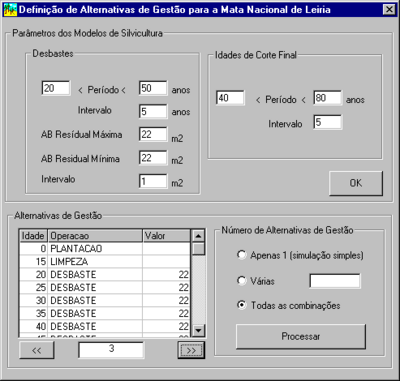SADfLOR/SAGfLOR
General System description
System name: Simulador de Alternativas de Gestão
Acronym: SAGfLOR
Brief Overview
SAGfLOR is the prescription writer of general system SADfLOR. SAGfLOR connects to the Management Information System INfLOR allowing for complex area selection procedures and generation of prescriptions or Linear or MIP programming models to be solved by the decision support models (DECfLOR).
Contents
Support for specific issues
Harvest scheduling, coppices management, cork yield.
Support for specific thematic areas of a problem type
- Silvicultural
- Certification
- Conservation
- Development choices / land use zoning
- Policy/intervention alternatives
Related systems
SAGfLOR is part of the set of tools SADfLOR, whom also belongs:
Data and data models
Typical spatial extent of application
It can be used both in forest and stand level.
Forest data input
Some data is required in order to build the management alternatives.
Type of information input from user (via GUI)
The user has to add some information in order to build the appropriate model, as target products flow or spatial relationships.
Models
Forest simulation models
SAGfLOR was built as an architecture that allowed adding modules for including several types of silviculture and species. In its current form it allows for simulation of the most important Portuguese forest species, namely:
- Maritime pine (Pinus pinaster Ait.)
- Cork oak (Quercus suber L.)
- Eucalypt (Eucalyptus globulus Labill.)
For simulation of Maritime pine stands was used on the northern coastal region, the stand level model DUNAS[1], and another model for inland mountainous regions [2]. For Eucalypt the version 1.0.1 of the GLOBULUS[3] model was implemented. Cork oak was the sole species that inclued an individual tree model, based on the SUBER [4] growth and yield individual tree model.
Output
Types of outputs
SAGfLOR outputs are harvest schedules shown in screen and ready to be used by the DECfLOR optimization tool.
System
System requirements
- Operating Systems: Microsoft® Windows™ OS
Architecture and major DSS components
It was developed using Microsoft Visual Basic™ and MapObject LT™.
Documentation and support
A user's manual has been published[5].
References
Cited references
- ↑ FALCÃO, A. (1999): DUNAS -- A Growth Model for the National Forest of Leiria. in AMARO A. et TOMÉ M. (Eds.), Proceedings in the IUFRO Workshop Empirical and Process-Based Models for Forest Tree and Stand Growth Simulation. Oeiras, Portugal: Ediçoes Salamandra, pp. 145-154.
- ↑ OLIVEIRA, A. (1985): Tabela de Produção Geral para o Pinheiro Bravo das Regiões Montanas e Sub-Montanas. Direcção Geral das Florestas. Centro de Estudos Florestais. INIC. Lisboa.
- ↑ TOMÉ, M.M., A. FALCÃO et A. AMARO (1998): GLOBULUS V.1.0.0: a regionalized growth model for eucalypt plantations in Portugal. in ORTEGA A. et GEZAN S. (Eds.), Modelling Growth of Fast-Grown Tree Species, Proceedings, IUFRO Conference. Valdivia, Chile: IUFRO, pp. 138-145.
- ↑ TOMÉ M., M.B. COELHO, H. PEREIRA et F. LOPES (1999): A management oriented growth and yield model for cork oak stands in Portugal. in AMARO A. et TOMÉ M. (Eds.), Proceedings in the IUFRO Workshop Empirical and Process-Based Models for Forest Tree and Stand Growth Simulation. Oeiras, Portugal: Ediçoes Salamandra, pp. 271-289.
- ↑ FALCÃO A. et J.G. BORGES (1999): SAGfLOR 2.0: Manual de Utilização. Simulador de Alternativas de Gestão. GEGREF Grupo de Economia e Gestão de Recursos Florestais. Documento No 5. 50pp.
